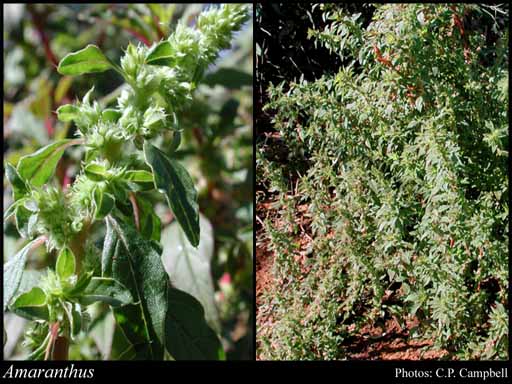- Reference
- Sp.Pl. [Linnaeus] 2:989 (1753)
- Name Status
- Current

Scientific Description
Family Amaranthaceae.
Habit and leaf form. Herbs. Annual; plants with neither basal nor terminal concentrations of leaves. Leaves alternate; petiolate; simple. Leaf blades entire; elliptic, or oblong, or rhombic, or ovate, or obovate, or trullate; pinnately veined; cuneate at the base, or oblique at the base, or rounded at the base. Leaves without stipules. Leaf blade margins entire. Leaf anatomy. Hairs absent.
Reproductive type, pollination. Fertile flowers functionally male and functionally female, or functionally male, or functionally female. Unisexual flowers present. Plants monoecious, or dioecious. Female flowers more numerous than the male flowers.
Inflorescence and flower features. Flowers aggregated in ‘inflorescences’; in spikes, or in fascicles (or clusters), or in panicles. The terminal inflorescence unit cymose. Inflorescences terminal, or axillary. Flowers bracteate; bracteolate. Bracteoles scarious. Flowers regular; cyclic. Free hypanthium absent. Hypogynous disk absent. Perianth sepaline; 3–5; accrescent (usually). Calyx present; 3–5; polysepalous; glabrous; regular; green, or red; scarious; with the median member posterior. Corolla absent. Fertile stamens present, or absent. Androecium 2–5. Androecial members all equal; free of one another; 1 -whorled. Stamens (2–)3–5; all more or less similar in shape; oppositisepalous. Anthers dehiscing via longitudinal slits; introrse; bilocular. Pollen shed as single grains. Fertile gynoecium present, or absent. Gynoecium 2–3 carpelled. The pistil 1 celled. Gynoecium syncarpous; synovarious to synstylovarious; superior. Ovary unilocular; 1 locular; sessile. Gynoecium non-stylate (stigmas sessile). Stigmas (2–)3. Placentation basal. Ovules in the single cavity 1; ascending; non-arillate; campylotropous.
Fruit and seed features. Fruit non-fleshy; dehiscent, or indehiscent; capsular-indehiscent (a utricule), or a capsule. Capsules when dehiscent, circumscissile. Fruit 1 seeded. Seeds lenticular; non-endospermic (strictly speaking). Perisperm present (abundant, mealy). Embryo well differentiated. Cotyledons 2. Embryo curved. Testa smooth (usually shiny).
Special features. Perianth (calyx) glabrous outside.
Economic uses, etc. Cultivated ornamentals and some noxious weeds.